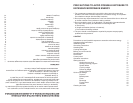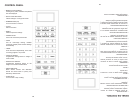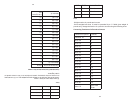2
2
INSTRUCCIONES IMPORTANTES
DE SEGURIDAD
Durante el uso de electrodomésticos, precauciones básicas de seguridad deben
ser tenidas en cuenta, incluyendo lo siguiente:
ADVERTENCIA – Para reducir el riesgo de quemadura, calambres eléctricos,
fuego y lesión a personas o exposición excesiva a la energía microonda:
1. Lea todas las instrucciones antes de usar el aparato.
2. Lea y sigue las “PRECAUCIONES PARA EVITAR LA POSIBLE EXPOSICIÓN
EXCESIVA A ENERGÍA MICROONDA” en la página 1.
3. Este aparato debe estar conectado a tierra. Conecte sólo a enchufes adecua-
damente conectado a tierra. Vea “Instrucciones para conectar a tierra” en la
página 3.
4. Instale y localice este aparato sólo acorde con las instrucciones de instalación
dadas.
5. Algunos productos como huevos enteros y contenedores sellados – por
ejemplo frascos de vidrio - pueden explotar y no deben ser calentados en este
horno.
6. Utilice este aparato solo para el uso intencionado que describe este manual.
No utilice químicos corrosivos o vapores en este aparato. Este tipo de horno
está especícamente diseñado para calentar, cocinar o secar comida. No está
diseñado para uso industrial o de laboratorio.
7. Como con todo aparato, es necesario una supervisión cuando sea utilizado por niños.
8. Para reducir el riesgo de fuego en la cavidad del horno:
a. No sobre cocine la comida. Esté cuidadosamente atento del aparato cuando pa-
pel, plástico u otros materiales combustibles sean colocados adentro del horno
para facilitar la cocción.
b. Remueva amarres de alambres de bolsas de papel o plástico antes de colocar
la bolsa adentro del horno.
c. Si los materiales dentro del horno se enciende, mantenga la puerta cerrada,
apague el horno y desconéctelo de la energía o utilice los tacos de electricidad
para detener la transmisión de energía.
d. No utilice la cavidad para usos de almacenaje. No deje productos de papel,
utensilios de cocina o comi da dentro del horno cuando no está en uso.
9. Líquidos, tales como el agua, café o té puede ser sobre calentados pasado
el punto de ebullición sin la apariencia de estar hirviendo debido a la tensión
en la supercie del líquido. Ebullición o burbujeo no siempre está presente cu-
ando el contenedor se remueve del horno. ESTO PUEDE RESULTAR EN QUE
LÍQUIDOS MUY CALIENTES DE REPENTE SE DERRAMEN CUANDO UNA
CUCHARA U OTRO UTENCILIO SEA INSERTADO AL LÍQUIDO. Para reducir
el riesgo de lesión a personas:
a. No sobre caliente el líquido.
b. Revuelve el líquido tanto antes como en el medio del su calentamiento.
c. No utilice contenedores de lados derechos con cuellos angostos.
d. Luego de calentar, permita que el contenedor se quede en el horno microondas
por un tiempo corto antes de remover el contenedor.
IMPORTANT SAFETY INSTRUCTIONS
When using electrical appliances, basic safety precautions should be followed,
including the following:
WARNING - To reduce the risk of burns, electric shock, re, injury to persons or
exposure to excessive microwave energy:
1. Read all instructions before using the appliance.
2. Read and follow the specic “PRECAUTIONS TO AVOID POSSIBLE
EXPOSURE TO EXCESSIVE MICROWAVE ENERGY” on page 1.
3. This appliance must be grounded. Connect only to properly grounded outlet. See
“GROUNDING INSTRUCTIONS” on page 4.
4. Install or locate this appliance only in accordance with the provided installation
instructions.
5. Some products such as whole eggs and sealed containers -for example, closed
glass jars- are able to explode and should not be heated in this oven.
6. Use this appliance only for its intended use as described in this manual. Do
not use corrosive chemicals or vapors in this appliance. This type of oven is
specically designed to heat, cook, or dry food. It is not designed for industrial or
laboratory use.
7. As with any appliance, close supervision is necessary when used by children.
8. To reduce the risk of re in the oven cavity:
a. Do not overcook food. Carefully attend appliance when paper, plastic, or other
combustible materials are placed inside the oven to facilitate cooking.
b. Remove wire twist-ties from paper or plastic bags before placing bag in oven.
c. If materials inside the oven should ignite, keep oven door closed, turn oven off,
and disconnect the power cord or shut off power at the fuse or circuit breaker
panel.
d. Do not use the cavity for storage purposes. Do not leave paper products, cooking
utensils or food in the cavity when not in use.
9. Liquids, such as water, coffee, or tea are able to be overheated beyond the
boiling point without appearing to be boiling due to surface tension of the
liquid. Visible bubbling or boiling when the container is removed from the micro-
wave oven is not always present. THIS COULD RESULT IN VERY HOT LIQ-
UIDS SUDDENLY BOILING OVER WHEN A SPOON OR OTHER UTENSIL IS
INSERTED INTO THE LIQUID. To reduce the risk of injury to person:
a. Do not overheat the liquid.
b. Stir the liquid both before and halfway through heating it.
c. Do not use straight-sided containers with narrow necks.
d. After heating, allow the container to stand in the microwave oven for a short time
before removing the container.
e. Use extreme care when inserting a spoon or other utensil into the container.
10. Do not heat oil or fat for deep-frying. It is difcult to control the temperature of
oil in microwave oven.
11. Pierce foods with heavy skins such as potatoes, whole squash, apples and
chestnuts before cooking.
12. The contents of feeding bottles and baby jars should be stirred or shaken and
the temperature should be checked before serving in order to avoid burns.


















